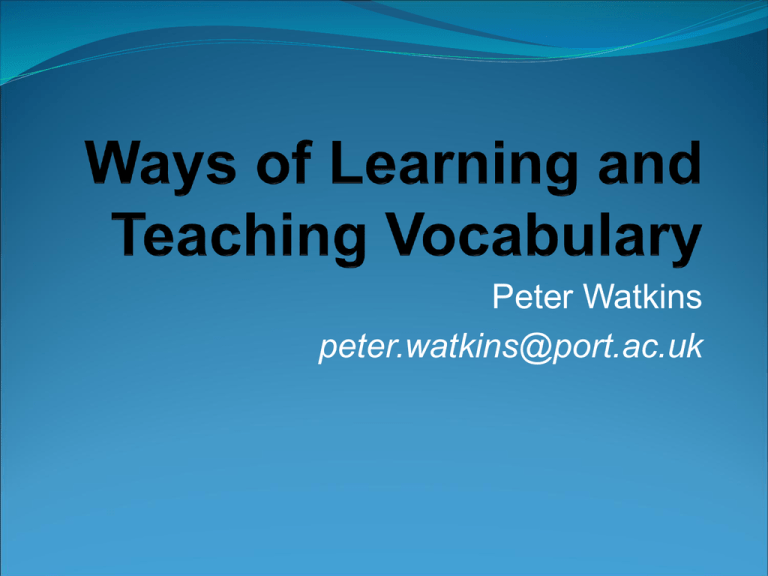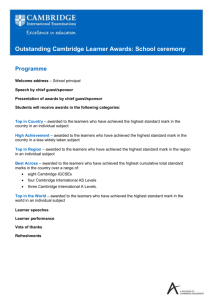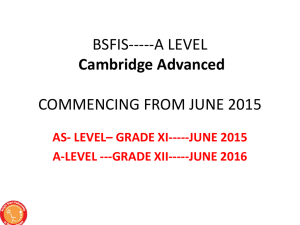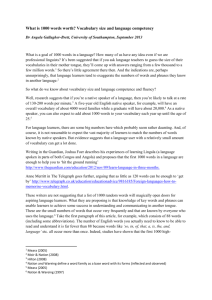Ways of Learning and Teaching Vocabulary
advertisement

Peter Watkins peter.watkins@port.ac.uk What do we mean by vocabulary? “There are some groups of words, like good morning and at the end of the day, which seem to be used like single words. Some of the groups may be items that have not been analysed into parts but are just learned, stored and used as complete units.” (Nation and Meara, 2010, p.35) Ways of looking at vocabulary We can study how words link together, their relationships and patterns how people are likely to learn words and what is most likely to promote acquisition strategies for teaching words Teachers’ views Teacher 1: “I think vocabulary is the relatively easy part of language learning. It’s grammar that’s difficult.” Teacher 2: “I generally teach vocabulary before we do reading and listening work.” Teacher 3: “The whole question of vocabulary is difficult – just because there is so much of it – where do you start? There’s so much to learn.” Teacher 4: “The most important thing is to recycle it [vocabulary] – go over it again and again.” Teacher 5: “The advice I would give is to try to make vocabulary learning fun.” Teacher 6: “Practising is one thing, teaching is another!” No one right way… “Research has provided much useful information about vocabulary learning and instruction. What it has not provided is a simple formula for optimal instruction, because no such formula can exist.” (Beck, McKeown and Omanson, 1987, p.150) Theorization of practice “While traditional views of teacher learning often viewed the teachers’ task as the application of theory to practice, more recent views see teacher learning as the theorization of practice; in other words, making visible the nature of practitioner knowledge and providing the means by which such knowledge can be elaborated, understood and reviewed.” (Burns and Richards, 2009, p.4) “Practising is one thing, teaching is another!” implicit versus explicit instruction working out from context working out from morphology paraphrase o learner explanation o teacher explanation o translation o dictionaries o glossaries “Learning vocabulary is relatively easy” the place of vocabulary in language teaching: grammar-translation audiolingualism communicative language teaching lexical approach “The fact is that while without grammar very little can be conveyed, without vocabulary nothing can be conveyed.” [original emphasis] (Wilkins, 1972, p.111) “Learning vocabulary is relatively easy” what learners need to know: forms and meaning(s) – denotation and connotation collocations grammar (we will meet ourselves at 8.00*) relationships with other words style/appropriacy (father, dad, old man) “I teach vocabulary before texts” common practice adjusts level of text by supporting bottom-up processing essentially a strategy to support other skills, particularly reading and listening see words in context can study texts after reading too Vocabulary teaching questions: Are the words frequent and useful? How will the words will be recycled? “There’s so much vocabulary to learn” 3000 word families give somewhere around 90-95% text coverage more would be needed for more specialized texts – eg academic ones suggests a need for independent learning to be developed quality of learning, as well as quantity, is important “There’s so much vocabulary to learn” O’Keeffe, McCarthy and Carter (2007), cited in O’Keefe (2012) “Recycling vocabulary is important” and “make it fun” distributed practice seeing words in different contexts – ‘narrow’ reading Other factors are also important in learning vocabulary, particularly: depth of cognitive processing depth of affective processing Word search c a s i n o r o d a l o v e g a h k b o z o v e r t a k e r n j e t s e t l e e i s y o a e n l q m s u v e h p e t k n c a l s u v s a c a c j o e d a t h e y r e a p i t s t o p l w l e d d f n e r n y b o r a f e r r a u d x p o e p e i p r i n c e l r f i a t s b x x u t p o d i u m n h g a l l casino driver grand prix hairpin jet set overtake palace podium prince Word search c a s i n o r o d a l o v e g a h k b o z o v e r t a k e r n j e t s e t l e e i s y o a e n l q m s u v e h p e t k n c a l s u v s a c a c j o e d a t h e y r e a p i t s t o p l w l e d d f n e r n y b o r a f e r r a u d x p o e p e i p r i n c e l r f i a t s b x x u t p o d i u m n h g a l l casino driver grand prix hairpin jet set overtake palace podium prince Making sentences journey to work travels first long soon usually enjoys class trip a Jay journeys travel business has is hotel and a on going reading reservation Making sentences journey to work travels first long soon usually enjoys class trip a Jay journeys travel business has is hotel and a on going reading reservation Games to recycle vocabulary Games to recycle vocabulary syllable realia controlled practice antonym synonym meronym hyponym collocation connotation Odd one out To teach the word order: a) order command advise b) order tell instruct c) order ask obey demand suggest (from SÖkmen, 1997, p.243) Word bags Word bags • Begin a lesson by asking the learners to guess which words from the previous lesson you have put into the bag. • Take five or six words at random from the bag, check the meanings and ask the learners to use these words in a short narrative that they write with a partner. • The learners work in pairs. Give each learner three words from the bag. They have to elicit the words from their partner by describing the meanings or by giving other information. • Give the learners some nouns from the bag. Brainstorm adjectives and/or verbs that collocate with each one. • Ask a different learner each lesson to choose the words that should be put into the bag from that lesson. • At the beginning (or end) of a lesson, take five or six words from the bag and elicit each word from the learners by giving the meaning. (Watkins, 2013) Rewriting a text Recently I did a mediation between two families living in neighbouring houses. In one of the families, the father had a passion for restoring old cars. He’d work on these cars outside until quite late at night, and the front garden was full of bits of old car, oil cans and the like. The other family hated the noise and the mess but – as quite often happens, I’m afraid – they simply put up with the problem and hoped it would go away. (Tilbury, Hendra, Rea and Clementson, 2011, p. 104) Rewriting a text Recently I did a mediation between two families living in neighbouring houses. In one of the families, the father had a passion for restoring old cars. He’d work on these cars outside until quite late at night, and the front garden was full of bits of old car, oil cans and the like. The other family hated the noise and the mess but – as quite often happens, I’m afraid – they simply put up with the problem and hoped it would go away. (Tilbury, Hendra, Rea and Clementson, 2011, p. 104) Recently I did a mediation between two families living in near-by houses. In one of the families, the father liked working on old cars. He used to play around with these cars outside until really late at night, and the front garden was full of bits of old car, oil cans and other junk. Not surprisingly, the second family hated the noise and the mess but – as quite often happens, I’m afraid – they simply tolerated the problem and hoped it would go away. Learners’ strategies “Learning strategies are conscious mental and behavioural procedures that people engage in with the aim to gain control over their learning process. Strategies can be cognitive (among which memory-related and compensatory strategies are important), metacognitive, social and affective.” (Ortega, 2009, p.214) Learners’ strategies Anja: I read a text and write definitions of new words (from a dictionary) but I do not write the new word down. I try to remember the word that goes with the definition the next day. If I can’t, I reread the text and try the exercise again. If I do remember the word I write it down, although I sometimes wait to see if I can remember it after two or three days. David: I copy out the sentences from the text that have a new word in but in place of the new word I leave a gap. At university you have to read ______ journals (academic). Later I go back and try to fill in the gaps. Learners’ strategies Gaston: When I find a new word I ask myself as many questions as I can about it. What does it rhyme with? Where’s the stress? How many syllables does it have? What word class is it? What words are derived from it? What words combine with it? What does it make me think of? Aasmah: Whenever my teacher teaches me new grammar or vocabulary, I always try to use it over the next few days. I try to use it in lessons and outside if I can. That way I think I remember it better and I get feedback on if I’m using it properly. Patricia: I try a few different things to learn vocabulary. Whenever I try a new method, I always ask myself if it is better than other things I use. I think that’s important. (adapted from Watkins, 2014, p.104-5) Bibliography Beck, I.L., McKeown, M.G., and Omanson, R.C. (1987). The effects and uses of diverse vocabulary instructional techniques. In M.G. McKeown & M.E. Curtis (Eds.), The Nature of Vocabulary Acquisition (pp. 147-163). Hillsdale, NJ: Erlbaum. Burns, A. and Richards, J.C. (2009). Introduction. In A. Burns, & J.C. Richards (Eds.), The Cambridge Guide to Second Language Teacher Education (pp.1-8). New York: Cambridge University Press. Nation, P. and Meara, P. (2010). Vocabulary. In N. Schmitt (Ed.), An Introduction to Applied Linguistics (pp.34-52). Abingdon: Hodder Education. O’Keeffe, A. (2012). Vocabulary instruction. In A. Burns, & J.C. Richards (Eds.), The Cambridge Guide to Pedagogy and Practice in Second Language Teaching (pp.236245). New York: Cambridge University Press. Ortega, L. (2009). Understanding Second Language Acquisition. London: Hodder Education. SÖkmen, A. (1997). Current trends in teaching second language vocabulary. In N. Schmitt & M. McCarthy (Eds.), Vocabulary: Description, Acquisition and Pedagogy (pp.237257). Cambridge: Cambridge University Press. Tilbury, Hendra, Rea and Clementson (2011). English Unlimited Upper Intermediate. Cambridge: Cambridge University Press. Watkins, P. (2014). Learning to Teach English (2nd ed.). Peaslake: Delta Publishing. Watkins, P. (2013). By teachers, for teachers. English Teaching Professional, 84. Wilkins, D. (1972). Linguistics in Language Teaching. London: Edward Arnold.







